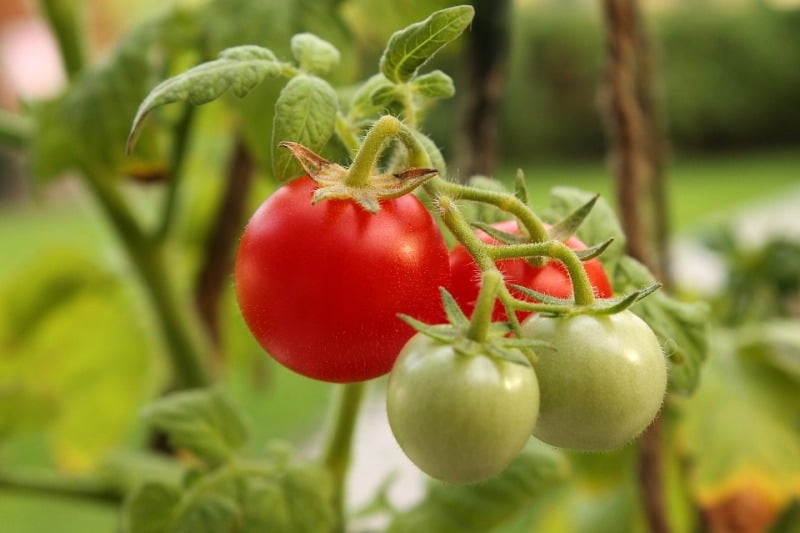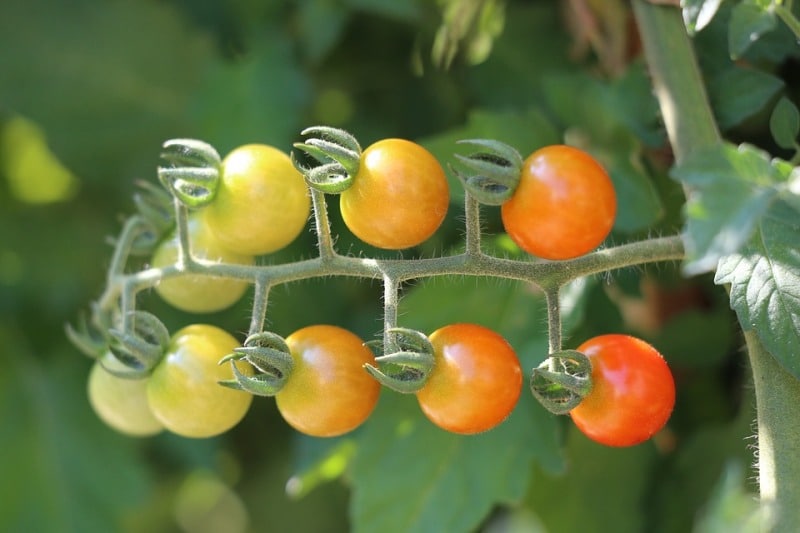A step by step guide for Cherry tomato farming in India
Today, we are presenting the cherry tomato farming guide along with cultivation practices like cherry tomato spacing, transplanting, sowing methods, cherry tomato varieties, Cherry tomato care, and harvesting procedure.
Cherry tomatoes are small, round, cherry-sized fruits of the family Solanaceae. Cherry tomato (Solanum Lycopersicum var. cerasiforme) is a highly-priced culinary as well as it is an ornamental vegetable.

Cherry tomatoes are normally much sweeter than large tomatoes. The size and color of Cherry tomatoes have a wide range, as there are hundreds of different varieties. The perfect Cherry tomato could be, first and foremost, in-season. It must be almost firm, thin, and smooth-skinned. The Cherry tomato flavor will be a fine balance of sweet and tart. Like all tomatoes, the classification of Cherry tomatoes based on how they grow, as their plants generate in two different forms they are determinate or indeterminate. Determinate type varieties grow on bush-like plants with short vines and bear just one crop per season, though indeterminate varieties are long, sprawling vine plants that bear fruit continuously throughout the season.
Seasons and availability of Cherry tomatoes:
Normally, Cherry tomatoes are available year-round with a peak season in the summer months.
Varieties of Cherry tomatoes:
The below-given list is about different varieties of Cherry tomatoes:
- Super Sweet 100 Cherry Tomato
- Italian Ice Cherry Tomato
- Yellow Pear Cherry Tomato
- Black Pearl Cherry Tomato
- Sun Gold Cherry Tomato
- Cherries Jubilee Cherry Tomato
- Bloody Butcher Cherry Tomato
- Green Envy Cherry Tomato
- Napa Grape Tomato
- Honeybunch Cherry Tomato
- Chadwick Cherry
- Isis Candy Cherry
Climate & Soil Requirement for Cherry tomato farming:
- Generally, Cherry tomato farming in India is a relative warm-season crop. Cherry tomato plants grow well at the temperature range of 19°C to 30°C. It requires plenty of Sunshine but low humidity continuous rain in the hot weather will increase disease problems such as bacterial wilt, blight, rot, and Fruit cracking.
- Cherry tomato grows best on deep sandy loam or clay loam soil with pH level 6-7, good water holding ability, rich organic matters and good drainage. The location must be free from nematodes and other soil-borne diseases.
- Succession cropping must be avoided because of bacterial wilt and other soil-borne disease problems. It is best to rotate tomato with rice and legume crops and wait for three years before plant it again on the same ground.
Seedling care in Cherry tomato farming:
As the seed of Cherry tomato is small, it is better to raise seedling using tray and coco peat media. Normally, 104 cup trays can be used. Raise the seedling in good nursery condition. Irrigate the seedlings to maintain enough moisture. High temperature and high humidity results in diseases like collar root, root rot. It takes 20 to 30 days from sowing to transplanting.
Transplanting and spacing in Cherry tomato farming:
- Transplant the seedlings at 5 to 6 true leaves stage. Space them 60cm apart in double rows on each bed spaced at 1.5 to 2 m wide.
- The seedlings should be sufficiently watered several hours before transplanting to make it easier to remove the plant from the pot or seedling bed. Thus the roots of seedlings can hold as much soil as possible, so as to prevent wilting during transplanting.
- Irrigation should be started immediately after the transplanting.
You may also like Tomato Profit Per Acre, Cost of Cultivation.
Fertilizer requirements for Cherry tomato farming

Fertilizers are applied before transplants are planted; side dressed in furrow irrigation systems or applied through the drip irrigation system. The term “chemigation” is the injection of any chemical such as nitrogen, phosphorus, or a pesticide into irrigation water and useful to the land using the irrigation system.
A general guideline for basal fertilizer dosage is 10-tonne FYM, 60 Kg DAP, 45 Kg MoP (Muriate of Potash), 50 Kg secondary nutrient mixture and 10 Kg micronutrient mixture per acre of field. Urea is not required if the above-mentioned dose of DAP (Diammonium phosphate) is applied, as the requirement of nitrogen will be met out of DAP itself. However, the precise requirement of fertilizers in a particular field must be calculated according to soil health card and on the basis of this general guideline. Half of the DAP and MoP can be applied as a basal dose and the remaining half at 15-20 days intervals throughout the crop life cycle. Biofertilizers like Azospirillum and Phosphobacteria can be mixed with FYM to increase and sustain nutrient uptake for a longer duration.
Water Management for Cherry tomato farming:
Cherry tomato is a shallow-rooted crop. Thus it is not drought resistant. It is mainly sensitive to water stress during fruit setting period. When the weather is hot and dry flowers and fruits drop simply. Therefore irrigation must be applied frequently to maintain steady growth.
Harvesting Cherry tomatoes:
Discard the first Tomato setting if the size of the fruit is bigger. Once you achieve the desired size, harvest the tomatoes in the early morning (when the temperature is low) by maintaining calyx if possible (it can give an attractive look to the fruit). Grade the fruits as per size and quality. Discard the abnormal shape or size, diseased, cracked fruits. Pack the tomatoes in ventilated boxes and send to the market.
You may also like Okra Farming Cost, Profits.
Some information about Cherry tomatoes:
Let us discuss some facts about Cherry tomatoes;
- Generally, Cherry tomatoes range in size from a thumb tip up to the size of a golf ball and can range from spherical to slightly oblong in shape.
- Cherry tomato plants offer yields for a total of 210 to 240 days a year; each plant produces 3 TO 4 kg over the period. Cherry tomato plants for one acre can accommodate 5,500 to 5,700 plants. The Cherry tomatoes shelf life will be 8 to 10 days. The major Cherry tomato producers are Spain, Morocco, and China; Europe and the Americas are the biggest consumer markets.
- The smallest Cherry tomato variety is generally less than three-quarters of an inch in diameter. There are yellow and red color varieties.
- Most Cherry tomato varieties are indeterminate tomatoes, which mean that the vine will maintain growing larger as time goes on. This is a very good thing from the standpoint of extending the harvest period.
- The Cherry tomato is regarded as a botanical selection of the cultivated tomato. It was generally cultivated in Central America when the Conquistadores arrived and is thought to be the ancestor of all cultivated tomatoes. The popular varieties today were developed in Israel.
- Cherry tomatoes are an heirloom tomato, which implies that they will produce true from seed. But there are a number of hybrids that grow as Cherry tomatoes that are quite popular.
- The Sweet 100 or Sweet One Million varieties of cherry tomato will provide a slightly smaller fruit that the heirloom cherry tomatoes. Other popular Cherry tomatoes are grape tomatoes. These aren’t as sweet but can be originated in some other colors, some with a purple hue to them.
- Cherry tomato plant varieties have an indeterminate growth habit. And this means they keep growing and bearing as long as temperature and light allow. They are essentially a vine and produce the most fruit when carefully pruned and trained vertically.
You may be interested in Growing Thyme Herb in the Home Garden.
Hi I am interested in farming cherry tomatoes. Could you provide the contact details of seed suppliers
Thanking you
Sarath